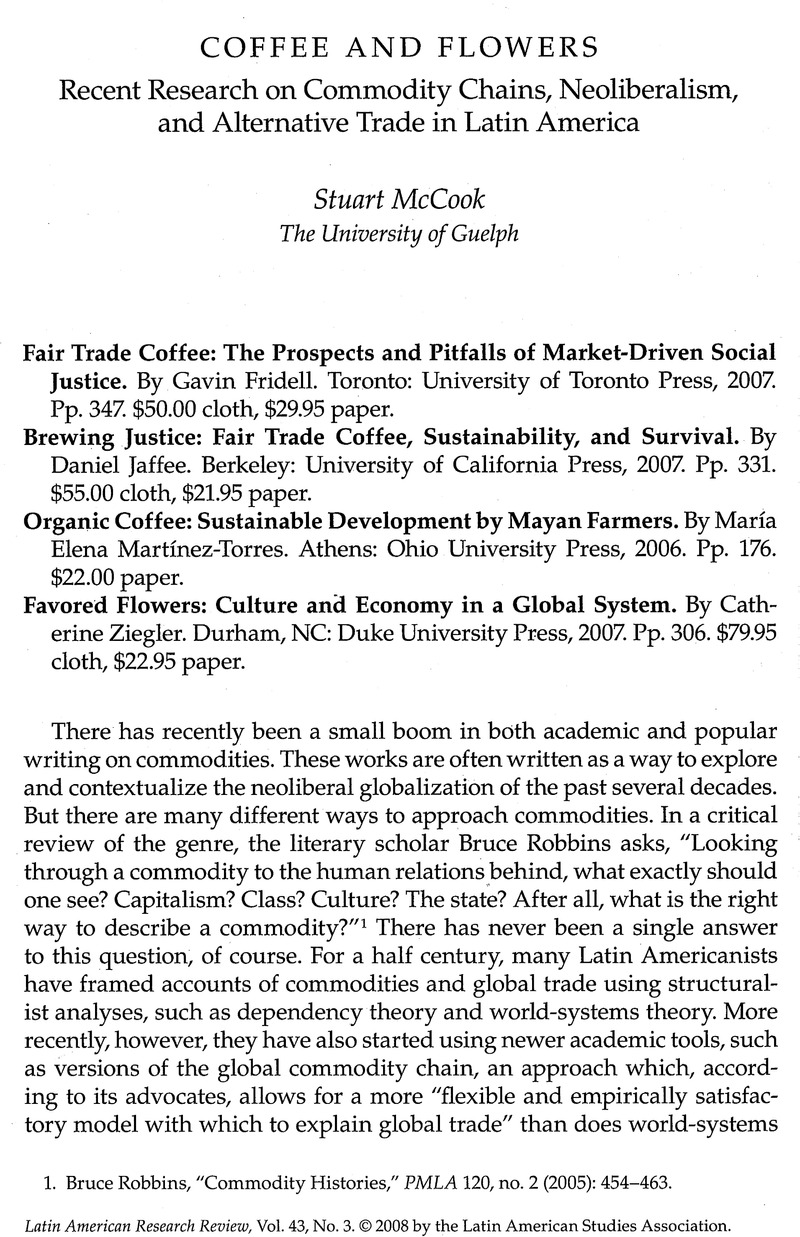Article contents
Coffee and Flowers: Recent Research on Commodity Chains, Neoliberalism, and Alternative Trade in Latin America
Review products
Published online by Cambridge University Press: 05 September 2022
Abstract

- Type
- Review Essays
- Information
- Copyright
- Copyright © 2008 by the University of Texas Press
References
1. Bruce Robbins, “Commodity Histories,” PMLA 120, no. 2 (2005): 454–463.
2. Steven Topik, Carlos Marichal, and Zephyr Frank, “Commodity Chains in Theory and in Latin American History,” in From Silver to Cocaine: Latin American Commodity Chains and the Building of the World Economy, 1500–2000, 1–24 (quotation at 14; Durham, NC: Duke University Press, 2006).
3. William Gervase Clarence-Smith and Steven Topik, eds., The Global Coffee Economy in Africa, Asia, and Latin America, 1500–1989 (Cambridge: Cambridge University Press, 2003); William Roseberry, Lowell Gudmundson, and Mario Samper Kutschbach, eds., Coffee, Society, and Power in Latin America (Baltimore: Johns Hopkins University Press, 1993); Nina Luttinger and Gregory Dicum, The Coffee Book: Anatomy of an Industry from Crop to the Last Drop, revised ed. (New York: The New Press, 2006).
4. William Roseberry, “The Rise of Yuppie Coffees and the Reimagination of Class in the United States,” American Anthropologist 98, no. 4 (1996): 762–775.
5. Robert A. Rice, “Noble Goals and Challenging Terrain: Organic and Fair Trade Coffee Movements in the Global Marketplace,” Journal of Agricultural and Environmental Ethics 14 (2001): 39–66 (quotation at 62).
6. Topik and Clarence-Smith, “New Propositions and a Research Agenda,” The Global Coffee Economy, 385–410.
7. Several studies of the banana trade have done this well. See John Soluri, Banana Cultures: Agriculture, Consumption and Environmental Change in Honduras and the United States (Austin: University of Texas Press, 2005); Steve Striffler, In the Shadows of State and Capital: The United Fruit Company, Popular Struggle, and Agrarian Restructuring in Ecuador, 1900–1995 (Durham, NC: Duke University Press, 2002).
8. BBC News, “Starbucks in Ethiopia Coffee Row” (accessed February 4, 2008, at http://news.bbc.co.uk/2/hi/business/6225514.stm).
9. See http://www.transfairusa.org/content/flowers (accessed February 4, 2008).
10. Steven Topik and Mario Samper Kutschbach compare national conventional coffee chains in “The Latin American Coffee Chain: Brazil and Costa Rica,” From Silver to Cocaine (Durham, NC: Duke University Press, 2006), 118–146.
- 2
- Cited by




